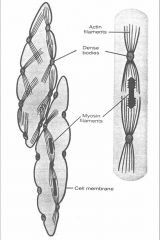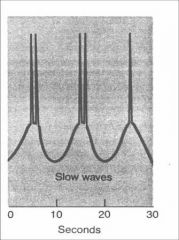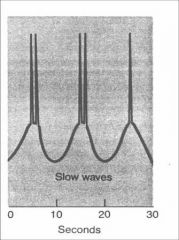![]()
![]()
![]()
Use LEFT and RIGHT arrow keys to navigate between flashcards;
Use UP and DOWN arrow keys to flip the card;
H to show hint;
A reads text to speech;
53 Cards in this Set
- Front
- Back
|
What are the two types of smooth muscles and which one is predominant?
|
1. Multiunit Smooth muscle
2. Unitary Smooth muscle (predominant) |
|
|
Describe the composition of multiunit smooth muscles.
|
Discrete smooth muscle fibers
|
|
|
Describe the composition of unitary smooth muscles.
|
Large conglomerate of smooth muscle fibers.
|
|
|
Describe the innervation of multiunit smooth muscle.
|
Each muscle fiber is individually innervated, thus FINE control.
|
|
|
Describe the innervation of unitary smooth muscle.
|
A single neuromuscular junction serves the entire bundle/sheet of smooth muscles. The (outer) cells that receive stimulus will transmit it to other cells via gap junction.
|
|
|
Unitary smooth muscle is also known as what?
|
Syncitial smooth muscle.
|
|
|
Examples of where you might find multiunit smooth muscle.
|
Ciliary muscle of eye
Iris of eye Piloerector |
|
|
Examples of where you might find unitary smooth muscle.
|
Blood vessels
GI tract Uterine wall |
|
|
What is the ratio of actin to myosin in smooth muscles?
|
15 actin to 1 myosin
|
|
|
Describe the organizational structure of actin and myosin in smooth muscles.
|
Irregular structure
|
|
|
In smooth muscle, what is analogous to the Z disc in skeletal muscle?
|

Dense bodies
|
|
|
Describe the sarcoplasmic reticulum in smooth muscle in comparison to skeletal muscles.
|
Much reduced in smooth muscles
|
|
|
Where does the calcium predominantly come from in smooth muscles?
|
Outside the cell (ECF)
|
|
|
Upon depolarization of smooth muscle cell membrane, the calcium comes in (from outside) and does what?
|
Binds to calmodulin
|
|
|
What activates the light chain kinase to phosphorylate myosin?
|
Calcium / calmodulin complex
|
|
|
What needs to happen to myosin so that contraction can occur?
|
Needs to be phosphorylated by light chain kinase and needs the presence of actin.
|
|
|
Why does smooth muscle stay contracted involuntarily?
|
Because an enzyme is needed for relaxation to occur.
|
|
|
Describe the four steps of contraction termination in smooth muscles.
|
1. Calcium channels close
2. Cytosolic Ca levels fall below "critical level" 3. Myosin light chain is dephosphorylated by myosin phosphatase. 4. Cross-bridge cycling stops. |
|
|
Compare speed of cross-bridge cycling in smooth muscle to skeletal muscle.
|
Slower in smooth muscle
|
|
|
Compare onset of contraction and relaxation after stimulus in smooth muscle vs. skeletal muscle
|
Slower in smooth muscle
|
|
|
Compare energy of sustained contraction in smooth muscle vs. skeletal muscle.
|
Less energy required in smooth muscle.
|
|
|
Compare maximum force of contraction in smooth muscle vs. skeletal muscle.
|
Greater in smooth muscle.
|
|
|
Compare degree of shortening in smooth muscle vs. skeletal muscle.
|
Greater degree in smooth muscle.
|
|
|
Compare the quantitative energy of sustained contraction between smooth muscle and skeletal muscle.
|
Smooth muscle uses 1/300th the energy of skeletal muscle to sustain a contraction
|
|
|
Describe the "Latch" mechanism.
|
Once smooth muscle in fully contracted, it will sustain it at 1/300 the energy of skeletal muscle.
|
|
|
What occurs slower in smooth muscle than in skeletal muscle?
|
1. Cycling of cross bridges
2. Relaxation 3. Contraction |
|
|
What are the two mechanisms of control in smooth muscle contraction?
|
Neural and hormonal mechanism.
|
|
|
Describe the receptors of muscle contraction in smooth muscles in comparison to skeletal muscles.
|
1. Smooth muscle membrane has many different receptor types (rather than just Na+/K+).
2. Smooth muscles also have receptors that can inhibit contraction (not seen in skeletal muscles) |
|
|
Do smooth muscles have discrete neuromuscular junctions?
|
No. Nerves terminate over muscle fibers, not in them.
|
|
|
Describe the actions of diffuse junction in smooth muscles.
|
Secretes transmitters into fluid surrounding muscle fibers.
|
|
|
What are the transmitting substances of autonomic nerves?
|
Acetylcholine and Norepinepherine
|
|
|
T/F - Acetylcholine and norepinephrine are released by the same nerve.
|
False - released by different nerves, where one is stimulatory and the other is inhibitory.
|
|
|
What is the general rule of ACh/NE effects on organs.
|
Action varies with organ type, but in general: if ACh excites, NE inhibits. and vise versa.
|
|
|
What is the resting potential in smooth muscles?
|
-50 mV.
|
|
|
Action potentials are seen in what type of smooth muscles?
|
In unitary smooth muscles, but not much in multiunit smooth muscles.
|
|
|
What are the two types of action potential seen in unitary smooth muscles?
|
1. Spike potential
2. Action potential with plateaus |
|
|
Describe the duration of spike potentials
|
10 - 50 milliseconds
|
|
|
Describe the polarization character of spike potentials with plateaus.
|
Very slow repolarization.
|
|
|
Where would you find spike potentials?
|
Places of peristalsis (approx. 8 contractions per minute)
|
|
|
Where would you find action potentials with plateaus.
|
In muscles requiring extended period of contraction usch as ureter, uterus, and vascular smooth muscle.
|
|
|
Describe the number of calcium channels in smooth muscle cells.
|
Calcium channels far exceed sodium channels in smooth muscle cells.
|
|
|
The flow of what is responsible for Action potential in smooth muscles.
|
Calcium
|
|
|
Describe the opening of calcium channels.
|
Opening is much slower.
|
|

What are the characters of these slow waves? X 3
|

1. Self excitatory
2. No extrinsic stimulus needed 3. Source of slow waves unknown |
|

What are the possible reasons for explaining slow waves?
|

1. Changes in Na pumping
2. Ion conductance changes 3. Leak of ions (either Na or Ca) |
|
|
Action potential is directly COUPLED with what in smooth muscles?
|
Contraction
|
|
|
What causes excitation by stretch in smooth muscles? X 2
|
1. Normal slow waves
2. Increase in membrane potential (less negative) |
|
|
Half of smooth muscle contraction is caused by what two factors?
|
1. Local tissue factors
2. Hormones |
|
|
What are the five local tissue factors?
|
1. Lactic acid
2. Acidity 3. Carbon Dioxide 4. Oxygen 5. Prostanoids |
|
|
How does hormones effect smooth muscle contraction?
|
Alters the ion conductance
|
|
|
T/F - Troponin - Tropomyosin complex seen in smooth muscles.
|
False
|
|
|
What are three major factors of contraction stimulation in smooth muscles.
|
1. Stretch
2. Hormones 3. Local factors |
|
|
What exhibits intrinsic contraction without external stimuli?
|
Slow waves
|

